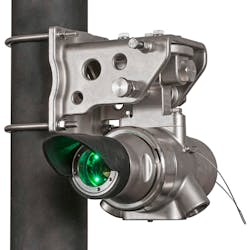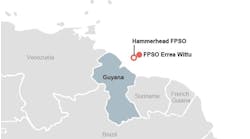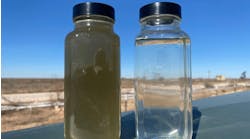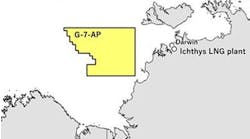Fire and gas detection technologies play important safety role in extreme offshore environments
Aaron Paterson, Det-Tronics
To perform their vital functions in harsh and remote applications, fire and gas safety systems should be designed to perform despite offshore conditions.
The list of the industry’s most demanding fire and gas (F&G) safety system applications includes offshore drilling platforms and FPSOs. At sites such as these, it is not enough to deploy systems that monitor high-risk processes involving combustible liquids and gases and respond quickly to danger signs. F&G systems used in offshore environments should be able to operate accurately and dependably when exposed to a wide range of external challenges, including violent storms, temperature extremes and vibration caused by wind and waves.
To meet these challenges, advanced F&G systems include special features that improve their performance and longevity in harsh and remote environments. The design and specification of these systems require the involvement of experts in the field. Practical knowledge of the subject enables oil rig managers, engineers, and other facilities personnel to contribute to the robustness of their F&G systems and to ensure proper installation, as well as operation and maintenance of the systems once they are in place.
The process of designing an F&G system normally begins with a safety assessment and a determination of the actions and components needed to create or upgrade the system. Functional safety-specific standards set by organizations such as the National Fire Protection Association, the International Electrotechnical Commission, and the International Society of Automation are helpful at this stage.
Third-party certifications confirm that F&G system components meet applicable standards, which have more rigorous requirements for applications in harsh marine environments. Agencies accredited to issue marine certifications include DNV GL, the American Bureau of Shipping (ABS), Lloyd’s Register, and the U.S. Coast Guard (USCG).
Since they can alert facility personnel of a gas leak before it ignites, combustible gas detectors are considered the first line of defense against fire. A gas detection system should be capable of giving an early warning of the presence of gas as well as the general location of an accumulation of flammable gas or vapor. Common fixed gas-leak detection technologies include:
Point detectors. Using electrochemical, catalytic or infrared (IR) technology, point detectors provide gas concentration measurements when they come in contact with combustible gases.
Line-of-sight (LOS) detectors. These detect gas along a path between a transmitter and receiver, normally using IR technology.
Acoustic detectors. Employing ultrasonic technology, acoustic detectors detect the unique sound signatures of high-pressure gas leaks.
LOS gas detectors are often used on the riser balconies of FPSO platforms, where challenges may occur. For example, salt can accumulate on the detector lenses, requiring maintenance by a specialized person who would scale and work on the outside of the hull. Because LOS detectors can be affected by vibration and ship movement, there may be misalignment between the detector’s light source and the receiver. To optimize performance of LOS gas detectors, specifiers should look for product features such as rigid mounting arms that reduce the effects of vibration from the mounting surface, as well as optics with relatively large alignment tolerances to help alleviate misalignment between the detector’s light source and receiver.
Optical flame detectors are devices that detect the radiant energy emitted by a flame. Offering detection speed and accuracy beyond the capabilities of conventional thermal detectors, optical flame detectors employ several sensing technologies, including ultraviolet (UV), IR, UV/IR and multi-spectrum IR.
The latest optical flame detectors are designed to perform in a wide range of sub-optimal conditions. For example, they can be fitted with weather shields that function like a hat brim to prevent rain and snow from collecting on the detectors’ optical surfaces. Detectors can also be designed with lens heaters to melt snow and ice, prevent condensation from forming and accelerate the drying process in humid conditions.
In addition to design features, installation techniques can help minimize the impact of precipitation on the performance of optical flame detectors. Since detectors usually monitor processes at or below their installed height, users should aim detectors at a downward angle. This provides more physical protection for the optics and also facilitates natural removal of precipitation via gravity.
In areas where heavy rain is accompanied by strong winds, there may be no way to prevent precipitation from accumulating on the detector’s optics. Eventually, this accumulation will significantly reduce the device’s original detection range. However, detectors equipped with a self-checking function can notify users of a decline in performance in the form of a fault. If faults occur frequently at a site that experiences heavy windblown precipitation, some detectors allow users to adjust the time between automatic self-tests and increase the required number of consecutive failed tests. These adjustments allow severe weather more time to pass before a fault is triggered. An examination of a detector’s event logs can help users determine the typical duration of an optical performance fault condition, as well as appropriate alternative fault settings.
Standards require high-hazard detector designs that are explosion-proof in the operating temperature range of the devices. This means detector housings must be capable of containing internal explosions so that hot gas and other byproducts do not escape and ignite surrounding hazardous substances. Because extreme heat or cold may create small gaps in detector housings, those deployed in such environments need to be impervious to change when exposed to severe temperatures.
Choosing an F&G safety system controller capable of sharing information via external communications can mitigate the downsides of remoteness. For example, connected detectors should have automatic self-test features that pull diagnostic information from the devices and make it available to remote personnel accessing the system. Maintenance can then be scheduled prior to the system entering a fault condition.
Redundant detectors are sometimes deployed in remote facilities in order to reduce the potential for false alarms. The idea is to implement a “voting” system involving multiple detectors in an area. When this configuration is employed, one fire alarm signal triggers notification of a potential threat, and two or more alarm signals trigger executive actions, such as equipment shutdown and/or suppression.
While redundant detectors and the other special features discussed above may increase the cost of an F&G system, the payoff is a comprehensive system that effectively protects a facility and its personnel from fire risks in some of the world’s most challenging environments. •



